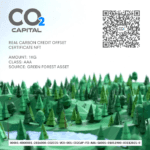Project Standards



Green Assets Projects
Organisations implementing projects to absorb emissions out of the atmosphere – through tree planting, algae farms, or carbon sequestration / storage technology.
Certification Standards
Principles and Requirements for Establishing Baselines, Monitoring, Quantifying, and Reporting Project Emissions. This framework is specifically designed to guide the process of determining baselines, monitoring, quantifying, and reporting project emissions for verification by CO2CCS. The ultimate objective is to facilitate the sale of resulting emissions reductions on CO2.CAPITAL’s voluntary carbon offset platform.



Certification Success RATE
Active Countries
Projects Certified
Green Asset Projects
Green Asset projects may include:
- Tree-planting and reforestation projects
- Forestry protection initiatives that prevent lodging or deforestation
- Algae farms
- Carbon storage technology (with prior assessment and consent from the independent carbon auditors to ensure performance validity)
Historic Problems with Forestry Projects
Forestry projects were historically vulnerable to several disadvantages which reduced their reliability:
• Double counting – forest projects typically cover very large areas of land, which means the number of trees is approximated instead of being specifically counted. This led to biases and inaccuracies with certain trees being counted twice and therefore being invalidly sold twice as separate offsets.
• Fallen trees – the existence of a tree today does not guarantee the existence of that tree tomorrow, even if the area is protected from lodging and human-caused deforestation. Trees can be felled by strong storm winds, can die due to disease or pest infestations, or can be destroyed by other natural forces such as acid rain or wildfires. Those trees cease to absorb carbon and, in the case of wildfires, could actually release all the carbon they had absorbed so far back into the atmosphere if the tree log is burned.
• Temporality – trees absorb different quantities of carbon dioxide at different stages of their life. New saplings typically remove far less carbon than fully grown trees, and mature or dying trees reaching the end of their lifespan similarly begin to experience reduced sequestration rates. Traditional attempts to certify and sell emissions reductions from trees have attempted to sell the entire lifetime absorption of the trees upfront, but this does not truly account for the actual climate impact over time.
The Solution
The CO2CCS unlocks the forestry market to significantly boost the potential range of projects that governments and organisations can use to achieve carbon neutrality. It does this by tackling the three key historic issues described above and tightening the quality standards surrounding green asset projects.
- Drone and satellite data collection technology – when a prospective forestry project signs up to the CO2CCS, cutting-edge scanning drones are deployed to accurately take stock of the carbon removal potential of that forest area using Light Detection and Ranging (lidar) technology. It does this by detecting and monitoring key parameters which determine the rate at which a region of forest absorbs carbon dioxide:
- The number of trees in the project area
- The species of trees contained in the area
- The maturity of the individual trees
- Monitoring the health and continued existence of each tree
- Science-based statistics – unlike existing carbon registries, the precise detection of the species and age of each tree ensures that an accurate picture of the tree’s true emissions removal rate can be calculated. Carbon offsets credits are then only certified and sold according to the real level of emissions that have been removed – guaranteeing genuine environmental impact instead of ‘hypothetical’ future impact.
- Insurance protection – each green asset (in this case: each individual tree which represents a unit of emissions reduction) is insured. That means that if the tree is detected to have perished in a wildfire or have died for any other reason, the insurance will cover the cost of planting replacement trees – thereby protecting the integrity of each carbon offset credit. In the event that a green asset is not insurable for any reason, a ‘buffer pool’ of 5 – 10% of the available stock of green assets will be held (not certified for sale during the application process) and used to replenish the stock of green assets. That is: a proportion of trees will be safeguarded and certified in the event that some of the trees forming part of the project are downed for any reason.
The use of breakthrough satellite surveillance technology to accurately track the number and condition of each tree, without human error, safeguards against double counting. The insurance cover (or buffer) ensures that the carbon removals that are promised by the sale of an offset are indeed materialised, even if the original tree(s) die. These pioneering steps enable forestry projects to be far more legitimately and transparently sold in voluntary carbon markets.
In addition to insuring each ‘Green Asset’ to automatically replace fallen or illegally lodged trees, CO2CCS forestry projects prevent and mitigate losses by applying key project quality principles and leading practices:
- Land zoning – we avoid partnering with projects that are planting in areas that are known to be highly prone to illegal lodging activities or frequent wildfires.
- Financial incentives – Revoking income from the sale of carbon offset credits at sites where there is evidence of the owner(s) intentionally cutting down, harming, or burning trees for other purposes.
- Planting native species – we do not partner with projects planting invasive species of trees in an area. All projects involve local, native species of trees which are known to thrive in the area providing the greatest chance of survival and longevity for each tree.
- Binding agreements – project owners sign legally binding agreements to maintain and protect their certified forests in accordance with the terms of the agreement(s). A breach of contract would instantly result in the project owner ceasing to receive the financial benefits of the CO2CCS certification and voluntary offset platform.
- Stakeholder engagement – if a project is being proposed on (or adjacent to) public lands or community areas, evidence of stakeholder engagement is required as a condition of the project’s certification. This raises awareness among local residents about the co-benefits of having additional forest lands nearby and empowers them to provide input to the project and feel that they are a part of it – reducing opposition.
- Resiliency – for Green Asset projects to be successful and generate peak carbon sequestration benefits is a long-term process. Regional conditions are not static and may change over time due to a range of potential factors such as shifts in the local communities’ size and composition, market fluctuations, and the impacts of climate change. Ongoing participatory monitoring and dialogue is therefore critical, and projects must be designed with the ability to adapt to foreseeable changes in economic, social, and ecological circumstances. Projects are therefore assessed to ensure resiliency and climate preparedness as part of the application process.
Requirements for Green Assets Certification
As noted in the start of this Chapter, Green Asset forestry projects must meet all of the eligibility requirements as standard carbon reduction projects (where applicable, see Chapter 3.1.2 for a detailed list of requirements). In addition, forestry initiatives must comply with (or consent to) the following:
- Drone and Satellite audit – project developers must consent to allowing access for CO2.CAPITAL’s drone scanning and satellite surveillance technology to scan and monitor the forest area to determine the health and quantity of trees in the project area. Project owners are also responsible for ensuring that any relevant permissions are sought to allow the flying of drones in the area – particularly if the project site is located near restricted zones such as airports. Drones are used for the initial scanning of the green assets, whilst satellite surveillance technology is used to track the ongoing health of the forest area(s) over time.
- Principle of Stewardship – project developers must agree to never knowingly and willingly cut, damage, burn or otherwise remove or kill the trees within their project area. Any felled trees or removed forests will not be eligible for renewed certification and cannot continue to be monetised on the CO2.CAPITAL AG voluntary offset platform.
- Principle of Science – based offsetting – CO2.CAPITAL will use the latest scientific data and drone scanning and satellite surveillance techniques to accurately determine the estimated carbon removal potential of the forest. However, over time, new science may emerge which changes our understanding of how much carbon a particular species or age of tree absorbs. In such cases, the number of certified emissions that can be sold as offsets may vary year-on-year even if the forest itself remains the same. The project developer must acknowledge the potential for such changes, and that CO2.CAPITAL therefore cannot guarantee the exact number of emissions removals that can be certified each year.
- Insurance eligibility – trees in the forest area will be insured to protect against accidental loss due to, for example, natural disasters. Insurance will not cover intentional or human-induced lodging or forest fires. The project owner must consent to allowing drone technology or human intervention to re-plant felled trees, financed by the insurance claims. If a project area’s Green Assets cannot be suitably and reasonably insured, the project owner may be asked to contribute a percentage of their trees (typically 5 – 10% dependent on a risk-based formula) to a “buffer pool” of credits which cannot be monetised initially but are certified if and when required when other trees are lost.
- Principle of Resilience – projects must assess and demonstrate the resilience of their forest area to climate change, lodging activities or any other relevant risks. Such activities may threaten the long-term integrity of the project’s certification, so project owners must demonstrate an understanding of (and preparedness for) potential socio-economic or ecological changes in the area.
- Mitigation and recovery strategies – in addition to showing an awareness of potential risks to the permanence of a forest as described above, project owners must demonstrate reasonable mitigation and recovery plans to prevent or rebound from potential degradation to their forest area.
- Monetization Disclosure – project developers and landowners must disclose whether their forest is currently monetized – be it through offset certification under a different scheme, through government subsidies, through the growing of produce or any other method. This may have implications for the ‘Additionality’ criteria set out in Chapter 3.1.3
- Carbon Rights – in some countries, the carbon stored in trees, and absorbed by trees, is owned by the state – even if it is on private land. In addition to the legal considerations outlined in the general eligibility requirements (Chapter 3.1.2), project owners must therefore ensure that their forest is not within a region where carbon rights are claimed by any government or other official authority. Projects are only eligible for certification when the forest owner has the ‘right to use’ or ‘proof of title’ to the underlying sequestered carbon.
- Deforestation Disclosure – reforestation cannot be implemented on lands that were deforested by the project owner, or a related entity, within the last 10 years. This is to ensure that there is not a counterproductive incentive for developers to cut down forests for the purpose of replanting them and reselling those as new credits. Project developers must confirm that they have not engaged in such practices.
- Staffing resource requirements – for afforestation or reforestation projects on private lands, there must be evidence of the technology or staff that will be deployed to physically plant and manage the trees.
-
Contact
Get in touch to start the primarily project approval and location scanning feasibility
-
Project Review
After collecting standard data about your project CO2.CAPITAL will confirm feasibility by issuing you a contract
-
Scan & Tokenize
Drone scanning job will be scheduled and the scanned green asset will be tokenized and made available for purchase through our offset platform
-
Earn
Project owner typically earn 50% of the net proceed from the carbon credits issued and sold for their project.
NO UPFRONT COSTS are to be disbursed by the project owner!


